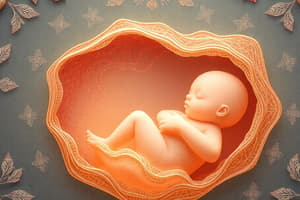Podcast
Questions and Answers
What structural unit is formed by the interdigitation of chorionic villi and uterine tissue?
What structural unit is formed by the interdigitation of chorionic villi and uterine tissue?
- Placenta (correct)
- Trophoblast
- Umbilical cord
- Fetus
Which hormone is NOT produced during pregnancy?
Which hormone is NOT produced during pregnancy?
- Thyroxine
- Human Chorionic Gonadotropin (hCG)
- Prolactin
- Luteinizing Hormone (LH) (correct)
What is a key function of the placenta during pregnancy?
What is a key function of the placenta during pregnancy?
- Production of white blood cells
- Development of the amniotic sac
- Formation of the embryo
- Oxygen and nutrient supply (correct)
Which layer of the blastocyst differentiates into the embryo after implantation?
Which layer of the blastocyst differentiates into the embryo after implantation?
What is the primary role of chorionic villi during early pregnancy?
What is the primary role of chorionic villi during early pregnancy?
What is necessary to maintain pregnancy immediately after implantation?
What is necessary to maintain pregnancy immediately after implantation?
Which hormone produced during pregnancy is primarily responsible for metabolic changes in the mother?
Which hormone produced during pregnancy is primarily responsible for metabolic changes in the mother?
What connects the placenta to the developing embryo?
What connects the placenta to the developing embryo?
Which hormone is detected in pregnancy tests due to its role early in pregnancy?
Which hormone is detected in pregnancy tests due to its role early in pregnancy?
What is the main structure responsible for nutrient exchange between the mother and fetus?
What is the main structure responsible for nutrient exchange between the mother and fetus?
Flashcards
Implantation
Implantation
The process where the blastocyst embeds in the uterine lining.
Chorionic Villi
Chorionic Villi
Finger-like projections that form the placenta.
Placenta
Placenta
Organ connecting the embryo/fetus to the mother, facilitating nutrient and gas exchange.
Umbilical Cord
Umbilical Cord
Signup and view all the flashcards
hCG (Human Chorionic Gonadotropin)
hCG (Human Chorionic Gonadotropin)
Signup and view all the flashcards
hPL (Human Placental Lactogen)
hPL (Human Placental Lactogen)
Signup and view all the flashcards
Estrogens & Progestogens
Estrogens & Progestogens
Signup and view all the flashcards
Inner Cell Mass (Embryo)
Inner Cell Mass (Embryo)
Signup and view all the flashcards
Trophoblast
Trophoblast
Signup and view all the flashcards
Endometrium
Endometrium
Signup and view all the flashcards
Study Notes
Pregnancy and Embryonic Development
- The trophoblast, part of the embryo, attaches to the endometrium.
- The uterine cells surround the blastocyst, leading to implantation.
- Finger-like projections (chorionic villi) develop on the trophoblast.
- Chorionic villi and uterine tissue interdigitate, forming a functional unit.
Placenta
- The placenta facilitates material exchange between mother and developing embryo.
- It provides oxygen and nutrients and removes waste.
- The placenta acts as an endocrine organ, producing hormones.
- Hormones like human chorionic gonadotropin (hCG), human placental lactogen (hPL), estrogens, progestogens, etc. are produced.
- Relaxin is produced in the later phase of pregnancy.
- Maternal hormone levels (like estrogens, progestogens, cortisol, prolactin, thyroxine) increase during pregnancy.
- These hormone increases support fetal growth and maternal metabolic changes.
- Immediately after implantation, the inner cell mass (embryo) differentiates.
Studying That Suits You
Use AI to generate personalized quizzes and flashcards to suit your learning preferences.



